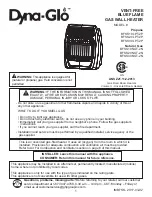
32
SUMMARY OF THE SAFETY
PRECAUTIONS
IMPORTANT – DANGER – CAUTION
·
Be sure to shut off operation before you sleep or go out (p. 34)
·
Never use highly volatile fuels, such as gasoline, etc (p. 35)
·
Shut off operation when refuelling (p. 35)
·
Check to see there is no oil leakage (p. 35)
·
Do not touch the warm air outlet during operation and immediately after the shutoff (p. 35)
·
Do not use the unit at the following places (p. 36)
·
Only top-quality liquid combustible for mobile heater, with the aromatics removed and totally free of impurities (max 1
% of aromatics and a flash-point above 61°) should be used (p. 42)
·
Check the flame for ignition (p. 45)
·
Preventing tampering (child safety lock) (p. 50)
·
This heater has been designed with an Air-sensor device based on the direct measurement of the CO2 rate in the
room. Abnormal conditions of use of your heater (bad ventilation or too small a room) will automatically provoke the
shut-off of your heater and the Air-sensor light will come on. (p.51)
·
Any tampering with or modification to the safety system is prohibited. Apart from invalidating the guarantee, this
would risk causing a failure of the system which is there for your safety (p. 51)
·
This heater may not be used in rooms which are hermetically sealed, such as caravans, boats, passenger
compartments of vehicles etc. (p. 51)
·
Use your heater in a room which is properly ventilated and free of inflammable vapours.
·
Each room that the heater is used in must be adequately ventilated (the ventilator window must have min a surface
area of 50 cm2) (p. 51)
·
Do not use your heater in too small a room . (p. 51)
·
In case of damage to the power cord, it must only be replaced by a workshop recognised by the manufacturer (or
distributor). (p. 51)
·
Always preserve a minimum clearance of 1 meter from other objects (p. 51)
·
Do not use your heater in rooms situated under the floor level (p. 51)
·
Whenever any of these safety systems is triggered, ventilate the room and check and eliminate the cause, and then
reignite. (p. 51)
·
Never disconnect electric parts and never replace it with non non standard parts. (p. 51)
·
Never disconnect neither the valve of the combustion control nor the combustion system (p. 51)
·
In case of damage to the power cord, it must only be replaced by a workshop approved by the manufacturer (or
distributor) because some tools are necessary. (p. 51)
·
Maintenance and regular maintenance (p. 52, 53 and 54)



































